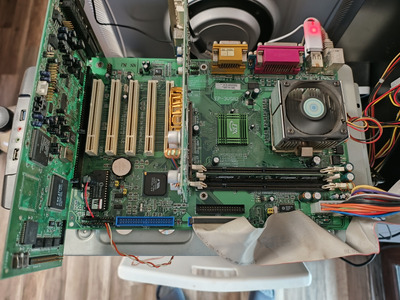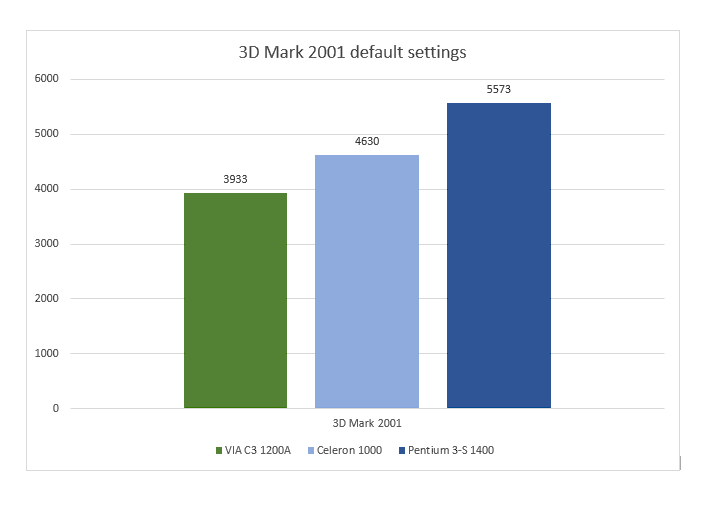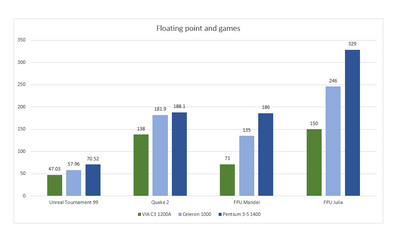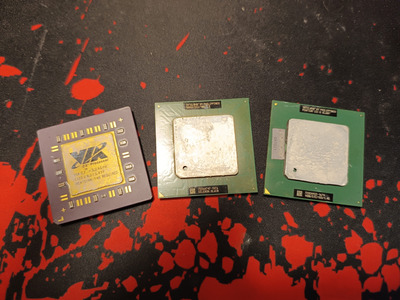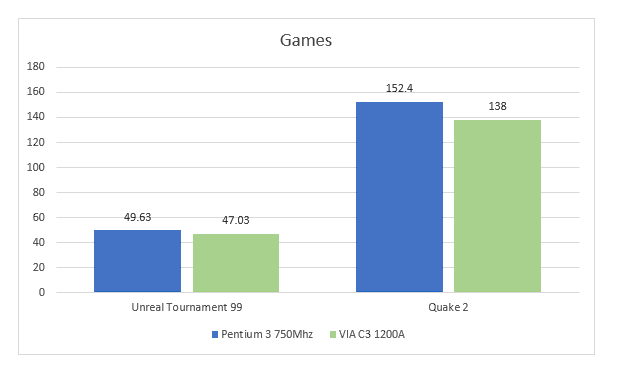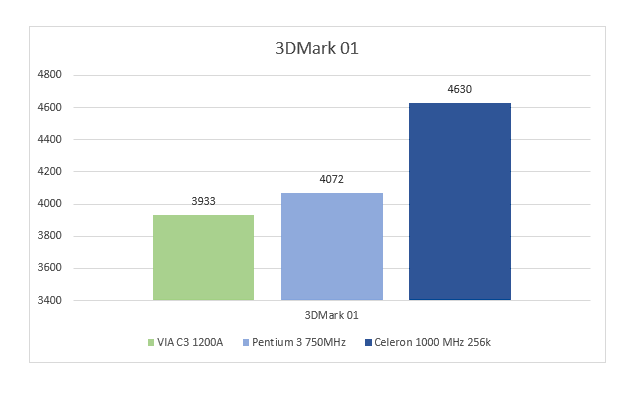shevalier wrote on 2023-09-22, 08:39:
Socket3 wrote on 2023-09-21, 19:26:
Conclusions:
- the Pentium 3-S 1400 is a MONSTER. In some tests is managed to overtake the 1000MHz tualeron by 20-33%.
Let me disagree.
But in terms of pure frequency, P3-S outperforms Tualeron by 40%.
The frequency difference is obvious, and by that metric the C3 is 20% faster then the tualeron, something that does not reflect in benchmark scores and as such not relevant. Here's how I calculated the differences in performance:
- 3dmark 01 - tualeron is 17% faster
- UT99 - tualeron is 23% faster
- Quake 2 - tualeron is 31% faster
Then I averaged the results -> (17+23+31)/3= 23.6% performance difference between the tualeron and the C3.
I did not bother applying the same methodology for the P3-S since the data is invalidated because of a clear GPU bottleneck (at least in quake 2) but here we go:
- 3dmark 01 - p3S is 20% faster
- UT99 - P3S is 21% faster
- Quake 2 - P3S is 3% faster
Averaging this out, the P3S winds up 14.6% faster according to my data.
shevalier wrote on 2023-09-22, 08:39:
It would be interesting to put the Tualeron on the 133 bus for comparison - it will be 1.33 GHz.
That's a good idea. I could try overclocking the tualeron 1000, but I haven't tested this chip extensively yet. Maybe I'll give it a go at one point.
HanSolo wrote on 2023-09-22, 11:01:
Such comparisons are always interesting. And time consuming to create, I suppose 😀
Socket3 wrote on 2023-09-21, 19:26:
There's about a 23% performance difference between the C3 1200A and the Tualatin Celeron 1000. Not great, not terrible. I suppose the C3 1200A performs close to an 833MHz Pentium 3 Coppermine.
If you mean the actual 'raw' computing power then I don't think your data backs that up. For such a comparison you need to eliminate the influence of the graphics card as much as possible. At least run the benchmarks at a very low resolution.
I agree. I did mention the GPU bottleneck and the fact that I want to redo all benchmarks with a Geforce 4 Ti4200. The P3S is clearly bottlenecked by the 5200, but the tualeron not so much.
HanSolo wrote on 2023-09-22, 11:01:
Both FPU tests indicate the Celeron to be 60% to 90% faster even at the lower clock speed. But those two test will probably emphasise the FPU which also doesn't tell the whole story.
That is also true, but as you can see, the synthetic FPU benchmarks don't have much bearing on actual gaming performance... in games, both direct3d and opengl the difference is much lower. In fact the results encouraged me to try out newer 2001 games like ground control and serious sam the first encounter - and I was very plesantly surprised to discover that both games are playable on the C3 Nemiah. I say surprised because I tried them a few years ago on a Samuel C3 and they were completely unplayable.
Garrett W wrote on 2023-09-22, 08:31:
I've found the Nehemiah to behave like a Coppermine clocked at half the frequency when it comes to 3D games.
That was true for the samuel core witch came with a FPU clocked at half speed and a 12 stage pipeline. The Nemiah is considerably faster. My experience so far is that the Nemiah chips offer ~65-70% the gaming performance of an equivalent coppermine, even more if the game uses SSE - witch is another difference between Samuel and Nemiah cores. Samuel lacks SSE but has 3DNow!. VIA removed 3dnow support from the Nemiah chips and added SSE. You can see this in the unreal tournament benchmaks, a game that makes use of the SSE instruction set.
When I find a bit more time I'll bechmark the C3 1200A against an 800MHz coppermine and post the results.
Garrett W wrote on 2023-09-22, 08:31:
If you want to do a proper test, I suggest tweaking BIOS settings a little bit (CL2 over CL3 timings is an easy one to spot) and using a different GPU with earlier drivers to remove CPU overhead and also run lower resolutions to ensure GPU is not the bottleneck in any given situation. Overclock that Nehemiah a little bit as well, I've seen people run theirs at 1533 and even 1600 MHz, but I guess I didn't win the silicon lottery!
Unfortunately the test rig was only stable using CL 2-3-2-5 with the VIA C3. The tualeron would hang in UT99 and the P3-S would boot loop with those memory timings... The C3 did manage over 900MB/sec memory read in everest at those timings, witch is pretty impressive.
As for overclocing, the EPOX board does not have an option for voltage in bios, best I could do is 1400MHz. My abit ST6 could probably push it further with a voltage bump, but I don't feel the need to overclock the chip, as frankly the difference in performance from 1200 to 1400mhz is not really noticeable in demanding games like UT99. If I recall it did manage to score 50fps, so a 3 fps increase for 200Mhz.... not great. Quake 2 and 3DMark 01 responded pretty well to the extra 200Mhz. I can't remember exactly what FPS it managed in quake but I do remember 3DMark score jumped to over 4000 pts.
rasz_pl wrote on 2023-09-22, 11:33:
VT82C694T does Interleave 4-Way, with everything tuned to the max its almost as fast as stock 440BX.
The Epox performs similarly to my Abit BE6-II when it comes to memory speed and latency. Memory read and write are a bit over 1000 pts on both boards using a pentium 3 1100 SL5QW (fsb 100) + slotket on the abit and the Pentium 3-S 1400 on the Epox. This with PC133 ram running at 100MHz CL 2-2-2-5 on the Abit and PC133 ram running at CL3-3-3-5 with 4 bank interleave on the Epox.
rasz_pl wrote on 2023-09-22, 11:33:
C3 looks really good in those tests, from my experience its much closer to Celeron 300@450.
That would be true for older Samuel and Erza-T C3 CPUs, the Nemiah is much faster, as it runs it's FPU at full speed as opposed to half speed (on the Samuel and Erza), and it has SSE instructions. Nemiah is about 70% the speed of an equivalent P3, even faster if the game takes advantage of SSE.
[EDITED] - I forgot to mention something very important, it relates to your experience - the motherboard must fully support the C3 Nemiah core - otherwise it will perform very poorly (as per your experience) or the system will be unstable. My EPOX fully supports the Nemiah with the latest BIOS, as does my Abit ST6 - but my MSI 694T PRO with stock bios does not - and the 1200MHZ nemiah performs closer to a 350MHz pentium II on that motherboard.
